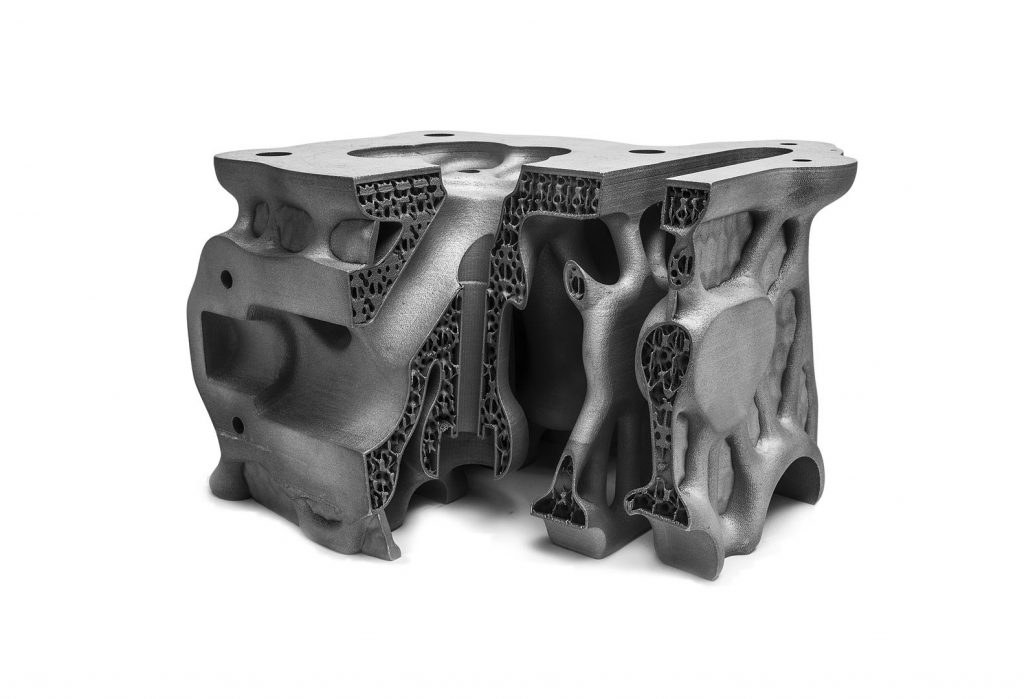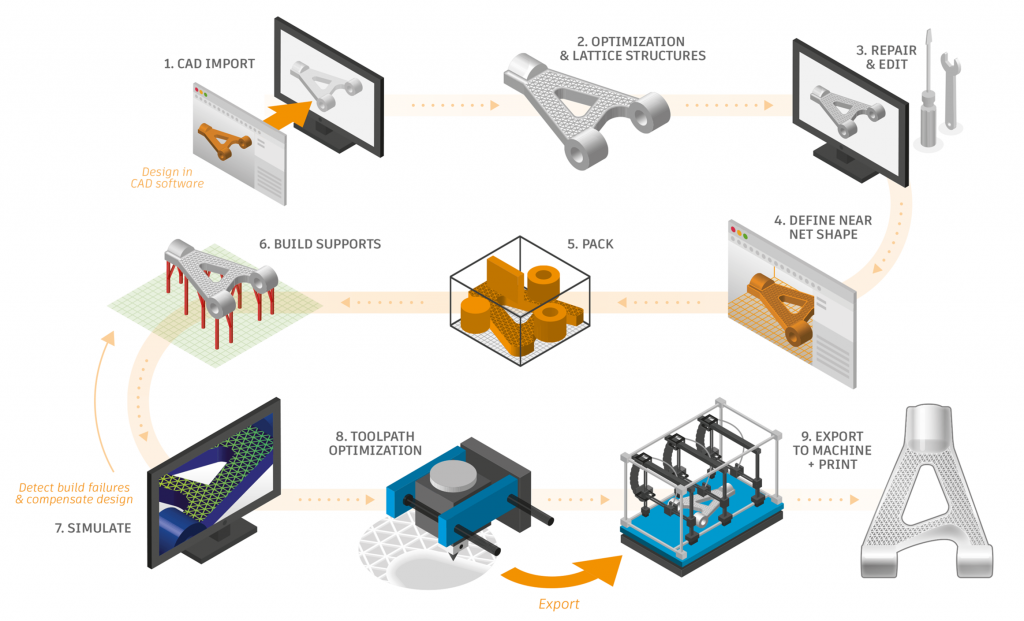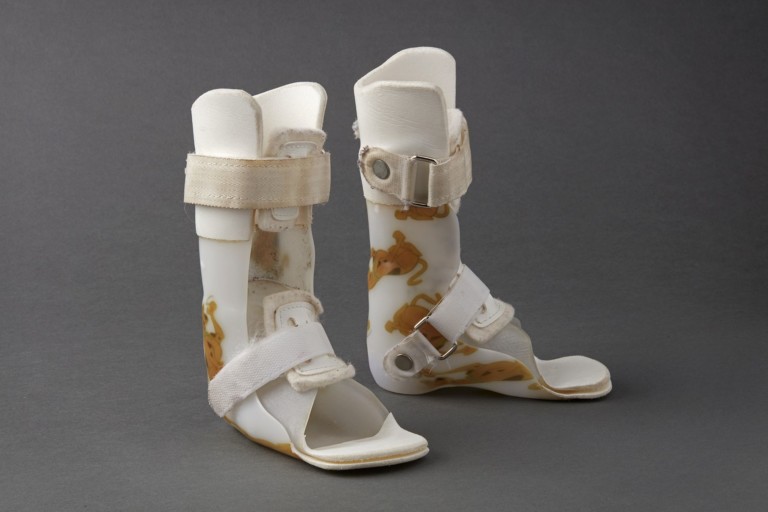Aurora Labs tests metal additive manufacturing process, delivering print speeds 55x faster than market standard
FELIXprinters releases two large-format FFF/FDM printers, technical specifications and pricing
Aircraft Philipp purchases GEFERTEC Arc605 3D printer for aerospace production
Interview with Alexander Oster of Autodesk
Alexander Oster is an extremely knowledgeable 3D printing person. If we’re looking at mesh repair or 3D printing files & software I’d consider Alexander the number one person worldwide. He also has a lot of manufacturing experience and this combined with his thorough knowledge of 3D printing software means he’s a veritable one man army in 3D printing. Alexander got started at one of the first 3D Printing service bureaus FIT (who pioneered SLA prototyping, prosthetics and manufacturing with 3D printing) singlehandedly wrote most of Netfabb and worked on some of the earliest 3D printing checking and pricing software. When Netfabb was acquired by Autodesk he moved to the company to become their Director of Additive Manufacturing. Alex is a great guy as well and has some very real nuanced insight to share with us.

Alexander Oster
How did you get into 3D printing?
I came in contact with 3D printers for the first time in 1998, when I had a student job at a local company that acted as Prototyping Service Provider for the Southern German Automotive Industry. At the time, they used this completely new and mind-blowing technology called Stereolithography in order to make prototypes and molds for investment casting.
The new thing about this method was that overnight it transformed the old craftmanship of model-making into a completely digital and high-tech activity – and there was almost no existing software stack available that would support this change. I had a good chunk of experience in programming 3D games, experience which we leveraged to help write a lot of in house software to keep the process working and efficient.
This company, FIT AG, still exists today and has become one of the premier additive contract manufacturers in Europe.
You wrote one of the first online software for 3D printing, what was that like?
Back in 2004, we mostly focused on the Design and Manufacturing of latticed part geometries years before everybody else sold this as “news”. For example, at the annual Euromold trade show 2006 we had a real size (about 3x3x3 meter) latticed tree on display – which was printed in Nylon and very lightweight due to its nature-inspired internal geometries.
It was unthinkable to do this in a CAD system at the time, so we had to find some shortcuts to directly create laser paths for use by the EOS plastic systems to handle the data appropriately.
But for our original geometry representation we still used (as did everybody else) triangles that were stored in the STL format. As this created a lot of instabilities and handling problems, we were forced to develop repair and fixing algorithms to mediate that. At this point, we did not make a commercially sellable product, but it was enough to be useful for others. So we released it as cloud service, and then cooperated with the newly founded Shapeways to streamline their customer upload process.
By coincidence this was also the time when the RepRap project and especially a small New York startup called Makerbot set out to make 3D Printing a known technology for the masses. Like in the industrial world, each one of those new 3D Printer users had a dire need to process all kinds of broken and invalid geometry files from a plethora sources – and this made the netfabb Cloud Services quite popular.
After a few years, we were very honored and excited that Microsoft took up the service as one of the first on their Azure platform; and connected it to the newly released Windows 10, with its built-in 3D Builder app.

You also wrote Netfabb, how has its functionality expanded?
Netfabb was the desktop version of this cloud service, and today has grown from a small tool that prepared STL files for 3D printing to a fully blown end to end solution for Additive Manufacturing. Particularly since our acquisition by Autodesk, we were able to quickly leverage the full force of a software giant and incorporate CAD kernels, Metal Process Simulation, Finite Element Solver, and advanced cloud capabilities. The whole software is now a puzzle piece in the much larger Autodesk Manufacturing world consisting of top-end vertical solutions for all each imaginable process of Digital Manufacturing – whether it be CNC operations (Autodesk PowerMill), composite manufacturing and cutting (Autodesk TruNest), or injection molding simulation (Autodesk MoldFlow).
This broadness of capabilities makes the Autodesk solution portfolio very unique in the market, and our tiered packaging model really has changed various developments in the industry. For example, at an entry-level price of only 200 US dollars per year we directly support hundreds of different 3D printers, affordable providing everybody in an organization access to 3D Printing data preparation. At the same time our high-end manufacturing and simulation solutions power the most advanced industrial applications on the planet.
What has changed in 3D printing industry during the time you were involved with it? Is the software landscape different now?
The major change between today and a decade ago is that nowadays a lot of large industrial players are investing huge amounts of capital, and new startups easily receive millions of dollars of venture funding with a well-presented idea that only exists on paper.
I am not sure if this is as bad as in other areas like Blockchain or Artificial Intelligence – but it has in my opinion skewed the market quite a lot and we are often seeing behind the scenes new entrants that are remaking all the mistakes that have already been made 10 years ago. This sometimes makes one feel sorry for all the lost money, but it also ensures that life stays exciting and it is not absolute that the most capital equipped player will in the end win the market.
From a software perspective, we are basically seeing what some people have predicted long time ago, which is basically the fact that the major large CAD vendors moved in and are incorporating 3D printing solutions into their products – and will in the long term dominate the software field. This is kind of unavoidable due to the important link between the design process of parts and the manufacturability constraints that naturally come with Additive Manufacturing.

What are Autodesk’s plans with 3D printing?
In addition to all of our Netfabb activities, I am specifically excited about our movement to integrate our manufacturing capabilities into Fusion 360. Fusion 360 is Autodesk’s next generation cloud-connected Design-to-Make platform, supporting all steps of the product development process, from conceptual design, mechanical design, CAE, CAM, and data management. And all of this backed by a cloud system that makes collaboration across different continents as effective as sitting next to each other.
A few months ago, we have released the first iteration of our Metal Additive capabilities inside of Fusion 360. Next to the established Fusion CAM module, this gives an amazing in-CAD experience for the user to quickly get from a design environment to a print ready file within seconds, and at the same time create the CNC postprocessing operation for the same part.
It is truly exciting to see the possibilities and the convergence of the design process of a product with the downstream manufacturing chain. And all of this in one place and in an associative way – which means once there is a change done upstream to the original design the manufacturing instructions are automatically updated accordingly. And all of this can be accessed at a subscription prices that will open up those capabilities to a vast group of designers and engineers who could not have afforded a fraction of capabilities before.

What do you see as the major roadblocks to 3D printing adoption?
While a lot of people still think about the quality aspects of Additive Manufacturing as the main issue, in my opinion the problem is more that the current cost structure of the technologies is far too expensive to make them viable in the mainstream. If the costs per part would be significantly lower, a lot of applications would open up where the quality problems we are seeing would be less relevant – casting for example has at least as many issues as additive, but is viable and widely used.
A lot of companies today are trying to reduce the costs by increasing production speed. This certainly helps, but in my opinion the real elephant in the room is the capital investment needed to really make use of the technology. You can easily find an entry level CNC equipment, and industrial robot or a state of the art injection molding machine for less than 50.000 US dollars, but one still requires millions of dollars to set up an efficient Additive Manufacturing operation, and even more millions to train engineers to properly take advantage of the process. Based on the amount of capital, this often means a lot of produced parts must be producted in order to amortize and therefore creates a high barrier for applications that are most suitable for 3D printing (i.e. the ones that have a low life time unit count).
The big democratization of 3D Printing has already occurred for stereolithography and FDM market, and I am sure we will also see it for the more industrial technologies too. And it will finally make the technology mainstream enough that the knowledge about them becomes ubiquitous.
What advice would you give me if I was an industrial company wanting to get started with 3D printing?
Do not invest millions of dollars in a in house technology park that will be outdated in a few years. Rather invest the money in product development together with a manufacturing partner and design consultants that can train you how to apply 3D Printing in the best way for your application.
How do you think that 3D printing could make a real impact on companies bottom lines?
I think this is not the right question, as this is always suggesting that we will build current products just a little bit cheaper when we 3D print them. In my opinion, the real question is much more which developments will not happen and which new businesses cannot be built without a major contribution of 3D Printing technology. And there the list is quite extensive.
I do not believe patient-specific implants are feasible without 3D Printing. I also believe there will be no walking robots without 3D printed components and no flying taxis. Or if you look at the current developments in the aerospace industry, we will not go to Mars without Additive Manufacturing involved, nor will we achieve environmentally sustainable air travel. Climate Change challenges, in general, will be very hard to tackle. If you look at the construction market for example, the amount of buildings the world needs to build in the coming decades for the billions of people moving into the middle class is mind-blowing. Neither enough resources nor the human capacity exists today to achieve this without destroying the planet. I do not believe that this will work out without proper automation, and advances in robotics and 3D printing will certainly play a key role in this. Dubai for example recently passed a law that 25% of its new buildings need to be 3D printed by 2025.
Independent how that will turn out, the future certainly will be exciting.
Australian Researchers Research Feasibility of 3D Printed Ankle/Foot Orthotics for Functionality & Comfort
 3D printing has played a large and varied role in medical implants, devices, and more. Australian researchers from the University of Sydney recently published ‘Feasibility of designing, manufacturing and delivering 3D printed ankle-foot orthoses: a systematic review,‘ outlining the challenges in traditionally made ankle-foot orthoses (AFO) and the broad potential for 3D printing in both manufacturing and health service delivery.
3D printing has played a large and varied role in medical implants, devices, and more. Australian researchers from the University of Sydney recently published ‘Feasibility of designing, manufacturing and delivering 3D printed ankle-foot orthoses: a systematic review,‘ outlining the challenges in traditionally made ankle-foot orthoses (AFO) and the broad potential for 3D printing in both manufacturing and health service delivery.
In examining the feasibility of customized, 3D printed AFOs, the team evaluated biomedical properties and outcomes, along with comparing fit and comfort levels. Eleven different studies were involved, with the scientists working to develop more lightweight, flexible, easy-to-use AFOs. Such devices are usually prescribed for kids and adults with conditions such as:
- Cerebral palsy
- Charcot-Marie-Tooth disease
- Cerebrovascular accident (stroke)
- Multiple sclerosis
Historically, AFOs have been known to be ill-fitting and uncomfortable, despite their intended use to help patients overall in walking, eliminating trips and falls, and assisting with balance. The scientists state that children, women, and individuals living at home alone tend to be most unhappy with traditional AFOs.
“… many children and adults with musculoskeletal and neuromuscular disorders don’t wear their prescribed AFOs and instead utilise compensatory strategies during gait despite these being physiologically inefficient and potentially injurious,” stated the researchers. “Therefore, many users only choose to wear their devices when their condition becomes severe even though earlier AFO use might have significant clinical benefits.”
Foot orthotics are usually made from plaster of Paris. Afterward, a thermoplastic vacuum forms over the positive model with polypropylene. There is extensive post-processing in this manual technique, and not only is it labor intensive, but limited in options for the patients, expensive, and it can take a long time for the patients to receive their devices. 3D printing in comparison can be exponentially faster, more affordable, completely patient specific in terms of fit, and offer more options.
“Novel patient-specific 3D printed AFOs are likely to have a dramatic effect on patient satisfaction, adherence to AFO usage and overall health related outcomes,” state the researchers.

An example of an ankle/foot orthosis (Photo credit: EOS)

(Photo credit: EOS)
Thirty-two adults participated, ranging from age 21 to 68.
“Four out of the eleven studies were conducted on patient populations including unilateral foot drop due to dorsiflexor weakness from stroke, cerebral palsy, L5 hernia, carbon monoxide intoxication and mechanical trauma, post-polio syndrome, trauma and cerebral palsy and an embolectomy. Six studies recruited healthy participants and one study did not report or evaluate the AFO in any participants (bench testing only).”
Ten of the studies explored whether or not a dynamic passive AFO (relying on the material properties and physical features to establish functional characteristics such as bending or rotational stiffness) was possible, while other studies integrated 3D printed parts with ‘off the shelf’ materials to produce ‘adustable stiffness.’
“Another study manufactured a segmented AFO consisting of a 3D printed calf section and foot section and a central interchangeable carbon fibre spring,” stated the researchers. “Similarly, another study integrated a commercially available metal hinge also capable of adjusting the stiffness of the AFO into a 3D printed articulated AFO.”
“Other designs also included an AFO with a 3D printed 3 mm calf and foot section connected with two carbon fibre rods and a 3D printed device supporting the ankle and foot and secured with laces. The only study that didn’t produce a dynamic passive AFO used 3D printing to produce a rigid (solid) AFO, however no testing was performed on the manufactured AFO.”
SLS 3D printing was used in the studies, with a wide range of varying materials, from nylon to resins to epoxy photopolymers. Assessments of the patients included how well they were able to walk, how comfortable the AFOs were, accuracy in fabrication, and mechanical properties. They found ‘significant differences’ in range of motion for the ankle, when comparing traditional AFOs and SLS AFOs, as the SLS AFO did exhibit less range of motion.
“Significantly reduced plantarflexion during the early stance phase was observed between stiffness conditions, with the higher stiffness setting allowing the minimal amount of plantarflexion,” stated the researchers. “They suggested that tailoring the stiffness of SLS AFOs may provide support to suit different activities in a way that traditional AFOs are unable to offer.”
In gait analysis, they also compared an FDM polyurethane AFO tightened with shoe laces to a traditionally manufactured rigid polypropylene AFO in one participant:
“They found that both AFOs similarly improved temporal spatial parameters compared to barefoot walking. However, ankle kinematic data showed that the traditional AFO was more effective in supporting ankle dorsiflexion during swing compared to the 3D printed AFO. The authors suggested that this 3D printed AFO needed to be designed in more dorsiflexion to compensate for stretching of the AFO during wear. However, this is likely due to the design of the 3D printed AFO which was developed to be more like a supramalleolar orthosis rather than an AFO as the device only surrounded the ankle and hindfoot and not the lower leg.”
In the end, the team found that overall 3D printed AFOs were as good in quality as their conventionally-made counterparts. Mechanical stiffness and energy dissipation of the 3D printed AFOs were found to be similar, but the researchers noted that sample sizes were small and ‘study quality was generally low.’
“The use of 3D printing to manufacture AFOs seems to have many potential benefits over traditional methods, including the development of novel designs that optimize stiffness and energy dissipation, improve walking biomechanics, comfort and fit,” concluded the team.
“The feasibility of using 3D printing to manufacture AFOs is dependent on the AFO design and printing method and therefore additional research is needed before 3D printed AFOs can be integrated into clinical practice. Further research is required to evaluate 3D printing AFOs in pediatric populations, and to determine the most appropriate printing technique and optimal materials to improve walking ability, patient satisfaction and long-term usage and durability.”
What do you think of this news? Let us know your thoughts! Join the discussion of this and other 3D printing topics at 3DPrintBoard.com.

Ankle-foot orthoses (Photo credit: BraceWorks)
Battery Dispenser – 36x AAA – Stackable with separate side plates, easier grip , mount holes #3DPrinting #3DThursday
Yezariael75 shared this project on Thingiverse!

Every Thursday is #3dthursday here at Adafruit! The DIY 3D printing community has passion and dedication for making solid objects from digital models. Recently, we have noticed electronics projects integrated with 3D printed enclosures, brackets, and sculptures, so each Thursday we celebrate and highlight these bold pioneers!
Have you considered building a 3D project around an Arduino or other microcontroller? How about printing a bracket to mount your Raspberry Pi to the back of your HD monitor? And don’t forget the countless LED projects that are possible when you are modeling your projects in 3D!
Car Cigarrette Power Box #3DThursday #3DPrinting
Shared by discostu on Thingiverse:
I have some car tools that I really like to use in my office table.
I think almost all the car cigarette power connectors will be valid since they are standard dimensions.
Print, share, use and modify it!
Enjoy!
Download the files and learn more

Every Thursday is #3dthursday here at Adafruit! The DIY 3D printing community has passion and dedication for making solid objects from digital models. Recently, we have noticed electronics projects integrated with 3D printed enclosures, brackets, and sculptures, so each Thursday we celebrate and highlight these bold pioneers!
Have you considered building a 3D project around an Arduino or other microcontroller? How about printing a bracket to mount your Raspberry Pi to the back of your HD monitor? And don’t forget the countless LED projects that are possible when you are modeling your projects in 3D!
Adafruit Grand Central M4 Express Stand #3DPrinting #3DThursday
krayola shared this project on Thingiverse!
A simple stand for the Adafruit Grand Central M4 Express to avoid scratching your desk.

Every Thursday is #3dthursday here at Adafruit! The DIY 3D printing community has passion and dedication for making solid objects from digital models. Recently, we have noticed electronics projects integrated with 3D printed enclosures, brackets, and sculptures, so each Thursday we celebrate and highlight these bold pioneers!
Have you considered building a 3D project around an Arduino or other microcontroller? How about printing a bracket to mount your Raspberry Pi to the back of your HD monitor? And don’t forget the countless LED projects that are possible when you are modeling your projects in 3D!
Dash Cam Visor/Windscreen mount #3DPrinting #3DThursday
jarm00725 shared this project on Thingiverse!
This is a dashcam mount for use on the windscreen with (adhesive 3m double side or alike) or to clip on the visor.
My original mount for this camera broke so I found another way to solve the issue by using and modifying to 2 different mount files in order to make them fit with my dash camera.

Every Thursday is #3dthursday here at Adafruit! The DIY 3D printing community has passion and dedication for making solid objects from digital models. Recently, we have noticed electronics projects integrated with 3D printed enclosures, brackets, and sculptures, so each Thursday we celebrate and highlight these bold pioneers!
Have you considered building a 3D project around an Arduino or other microcontroller? How about printing a bracket to mount your Raspberry Pi to the back of your HD monitor? And don’t forget the countless LED projects that are possible when you are modeling your projects in 3D!




